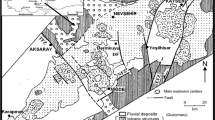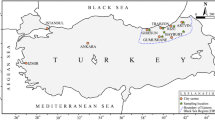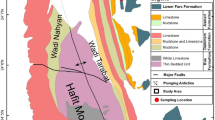Abstract
Preparing desired smooth specimens from pyroclastic rocks is difficult and time consuming for some standard tests such as uniaxial compressive strength (UCS) test, since they are weak or soft rocks. For this reason, the development of some equations is important for predicting the UCS of pyroclastic rocks. A linear correlation was suggested for the prediction of UCS from block punch index (BPI) test for a wide range of rock in the literature. The UCS–BPI conversion factor for this correlation is 5.1. In this study, the relation between UCS and BPI was investigated for pyroclastic rocks. Twenty-eight different samples of pyroclastic rocks were collected from the Cappadocia Region of Turkey. The UCS and BPI tests were carried out on the oven-dried samples in the laboratory. The test results were analyzed using the method of least squares regression. The linear regression analysis showed that the UCS–BPI conversion factor for the tested rocks was 3.1. This value is fairly lower than the suggested value. On the other hand, the correlation coefficients of power law functions are higher than that of the linear functions. Concluding remark is that the UCS–BPI conversion factor for the pyroclastic rocks is lower than the suggested general conversion factor and the UCS–BPI relation is best represented by the power law function.



Similar content being viewed by others
References
ASTM (1986) Standard test method of unconfined compressive strength of intact rock core specimens. Annual Book of ASTM Standards, (Vol. 04.08). ASTM D2938. American Society for Testing and Materials, Philadelphia
Basu A, Kamran M (2010) Point load test on schistose rocks and its applicability in predicting uniaxial compressive strength. Int J Rock Mech Min Sci 47:823–828
Broch E, Franklin JA (1972) Point-load strength test. Int J Rock Mech Min Sci 9(6):669–697
Fener M, Kahraman S, Bilgil A, Gunaydin O (2005) A comparative evaluation of indirect methods to estimate the compressive strength of rocks. Rock Mech Rock Eng 38(4):329–343
Gaviglio P (1989) Longitudinal wave propagation in a limestone: the relationship between velocity and density. Rock Mech Rock Eng 22:299–306
Gokceoglu C, Aksoy H (2000) New approaches to the characterization of clay-bearing, densely jointed and weak rock masses. Eng Geol 58:1–23
Gunsallus KL, Kulhawy FH (1984) A comparative evaluation of rock strength measures. Int J Rock Mech Min Sci 21:233–248
ISRM (2007) The complete ISRM suggested methods for rock characterization, testing and monitoring: 1974–2006. In: Ulusay R, Hudson JA (eds.), Suggested methods prepared by the Commission on Testing Methods, International Society for Rock Mechanics, Compilation arranged by the ISRM Turkish National Group, Ankara, Turkey, Kozan Ofset
Kahraman S (2001) Evaluation of simple methods for assessing the uniaxial compressive strength of rock. Int J Rock Mech Min Sci 38:981–994
Katz O, Reches Z, Roegiers JC (2000) Evaluation of mechanical rock properties using a Schmidt hammer. Int J Rock Mech Min Sci 37:723–728
Kohno M, Maeda H (2011) Estimate of uniaxial compressive strength of hydrothermally altered rocks from northeastern Hokkaido, Japan, based on axial point load strength test results. Int J JCRM 7:17–23
Mishra DA, Basu A (2012) Use of the block punch test to predict the compressive and tensile strengths of rocks. Int J Rock Mech Min Sci 51:119–127
Sachapazis CI (1990) Correlating Schmidt hardness with compressive strength and Young’s modulus of carbonate rocks. Bull Int Assoc Eng Geol 42:75–83
Sayin MN (2008) Fairy chimney development in Cappadocian ignimbrites (Central Anatolia, Turkey). Ph.D. Thesis, Middle East Technical University. p. 137
Sulukcu S, Ulusay R (2001) Evaluation of the block punch index test with particular reference to the size effect, failure mechanism and its effectiveness in predicting rock strength. Int J Rock Mech Min Sci 38:1091–1111
Toprak V, Keller J, Schumacher R (1994) Volcano-tectonic features of the Cappadocian volcanic province. International volcanological congress—excursion guide, Middle East Technical University, Ankara
Ulusay R, Gokceoglu C (1997) The modified block punch index test. Can Geotech J 34:991–1001
Ulusay R, Gokceoglu C. (1998) An experimental study on the size effect in block punch index test. Int J Rock Mech Min Sci 35(4–5): 628–629 (In: NARMS’98 ISRM International Symposium. Cancun, Mexico, Paper No. 008)
Ulusay R, Gokceoglu C (1999) A new test procedure for the determination of the Block Punch Index and its possible uses in rock engineering. ISRM News J 6(1):50–54
Ulusay R, Gokceoglu C, Sulukcu S (2001) Draft ISRM suggested method for determining block punch strength index (BPI). Int J Rock Mech Min Sci 38:1113–1119
van der Schrier JS (1988) The block punch index test. Bull Int Assoc Eng Geol 38:121–126
Yasar E, Erdogan Y (2004) Correlating sound velocity with density, compressive strength and Young’s modulus of carbonate rocks. Int J Rock Mech Min Sci 41:871–875
Yesiloglu-Gultekin N, Gokceoglu C, Sezer EA (2013) Prediction of uniaxial compressive strength of granitic rocks by various nonlinear tools and comparison of their performances. Int J Rock Mech Min Sci 62:113–122
Acknowledgments
This study has been supported by the Turkish Academy of Sciences (TUBA), in the framework of the Young Scientist Award Program (EATUBA-GEBIP/2001-1-1). Author thanks to Mehmet Saribiyik for helping to carry out the experimental studies.
Author information
Authors and Affiliations
Corresponding author
Rights and permissions
About this article
Cite this article
Kahraman, S., Fener, M. & Kilic, C.O. A preliminary study on the conversion factor used in the prediction of the UCS from the BPI for pyroclastic rocks. Bull Eng Geol Environ 75, 771–780 (2016). https://doi.org/10.1007/s10064-015-0789-7
Received:
Accepted:
Published:
Issue Date:
DOI: https://doi.org/10.1007/s10064-015-0789-7




